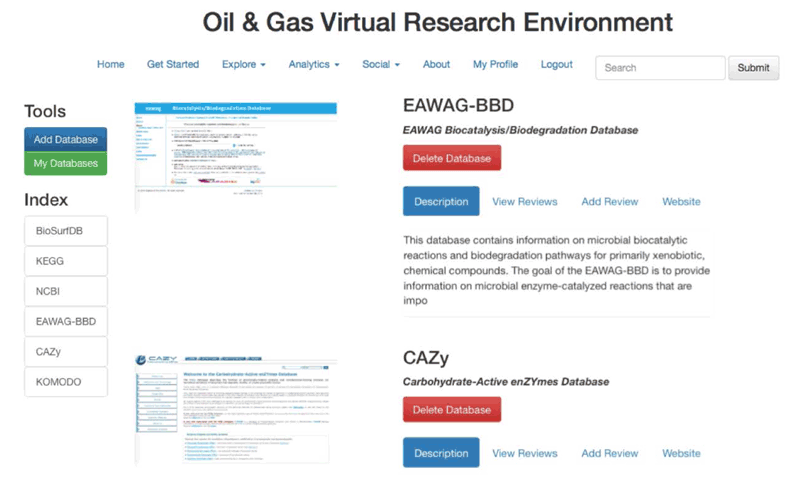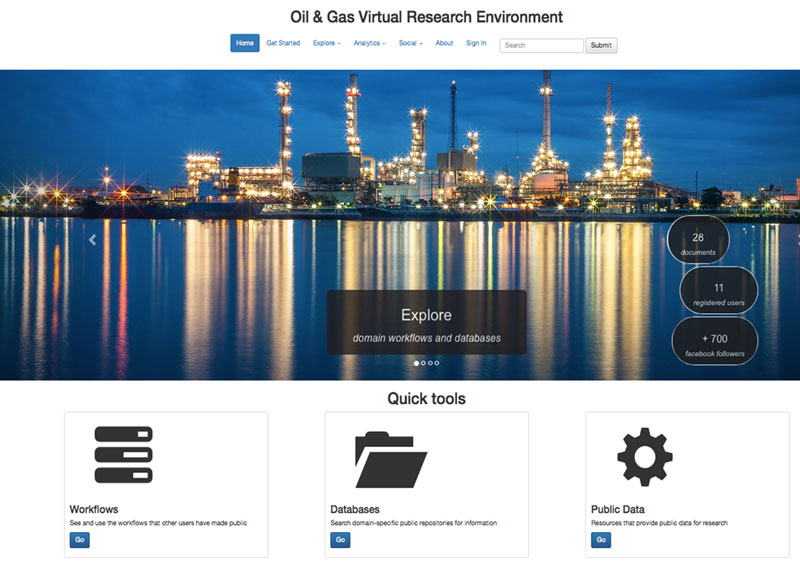by Jorge dos Santos Oliveira, José Borbinha and Ana Teresa Freitas (INESC-ID/IST, Universidade de Lisboa)
Microbial enhanced oil recovery gained a new meaning with the development of metagenomics. This genomic method involves identifying the collective genome of a microbial community, including those that cannot be cultivated in controlled conditions. However, this method generates petabytes of genomic data, presenting specific computational challenges, demanding the development of new collaborative research platforms. The main goal of this project is to develop a virtual research environment (VRE) that can support studies using metagenomic data with application to the oil and gas field.
In 2010, UK’s Joint Information Systems Committee (JISC) supported a landscape study on VREs. The research area with the largest number of identified examples of VREs was arts and humanities, followed by engineering and physical sciences and computer science, with biotechnology and biological sciences in fourth place [1]. The prominence of biotechnology and biological sciences VREs is interesting, given that there are usually ethical concerns with sharing data in these domains.
The most popular examples of VREs with an impact in biotechnology and biological sciences, are: (i) myExperiment [L1] – the main goal is to share and discuss workflows by providing networking tools to researchers; (ii) BioVel [L2] – a virtual e-laboratory which provides a graphical environment where researchers can design and construct analysis pipelines, before they are deployed through the BioVeL Portal and myExperiment; (iii) DECIDE [L3] – a VRE that helps the medical community with patient examination and diagnosis; and (iv) Genomics Virtual Lab [L4] that promises to take the IT out of bioinformatics by providing a cloud-based suite of genomics analysis tools.
Several factors can be seen as a barrier for the adoption of VREs in biotechnology and biological sciences, for instance, the complexity and consequent learning curve of such systems, often requiring IT knowledge; the ‘cultural’ habit of the (error-prone) physical notepad; and the broader approach to most of the research topics.
A ready-to-use application that has organisational and time-saving advantages over a physical notepad is required in order to increase the adoption of VREs in these domains. In this project, this particular question was addressed by acquiring feedback from laboratory teams during the development stages and by offering domain-specific information that is difficult to find just by browsing the web.
The new oil and gas VRE
This new oil and gas platform [L1] is a responsive web-based working environment, providing: (ii) workflow sharing, both bioinformatics and bench; (ii) access to algorithms and tools; (iii) access to databases and datasets related with biodegradation and biosurfactants; (iv) access to processing resources; (v) access to storage resources; and (vi) access to social tools.
In particular, the sharing of tailor-made computational and bench workflows is very useful in metagenomics research due to the novelty, heterogeneity and size of the data that is generated.

Figure 1: Database page, an example of the gallery-style sharing platform, where users can view, comment and review tools, or even submit their own.

Figure 2: Home page of the oil and gas VRE.
Another main problem faced by VREs is their sustainability. Each VRE tends to create all services from scratch, using resources that require high maintenance and large budgets. Consequently, activity within most VREs declines with time and they become dead resources.
In order to overcome this important issue, we adopted the strategy of relying on existing technology and resources as much as possible, using e-infrastructure standard APIs and formats, and following an API-first philosophy. For example, social share and discussion resources are Facebook, myExperiment and BitBucket; user authentication is based on the Google Sign In platform; and Google Analytics tool was integrated into the platform in order to provide real-time and long-term statistics of the VRE usage. All this is build in the flexible, cloud-friendly and JavaScript-centric MEAN Stack. This VRE also takes advantage of other existing specialised services, for example for the BioSurfBD database [2].
The project team
This project started in 2015 as part of a larger initiative aiming to develop a multidisciplinary approach to identify and characterise patterns of taxonomic and functional diversity of microbial communities present in reservoirs [3].
The project brought together more than 20 researchers, from three research institutes: (i) the Information and Decision Support Systems Lab (IDSS) research group from INESC-ID, Portugal, that has the knowledge to develop the computational biology algorithms, databases and the VRE; (ii) the Bioinformatics Laboratory of LNCC, Petropolis, Brazil, that is responsible for providing workflows and metagenomics sequencing data; and (iii) the Department of Biochemistry, Universidade Federal do Rio Grande do Norte, Brazil, that is responsible for the laboratory experiments and feeding the VRE with data.
Due to its flexibility, this VRE can be used in other domains. For example, a similar solution for the area of precision medicine has already been proposed.
Links:
[L1] https://www.myexperiment.org/home
[L2] http://www.biovel.eu/
[L3] http://applications.eu-decide.eu/
[L4] http://nectar.org.au/
[L5] http://aleph.inesc-id.pt/vre/, https://www.facebook.com/ogvre/
References:
[1] A. Carusi and T. Reimer: “Virtual research environment collaborative landscape study,” UK’s Joint Information Systems Committee, Tech. Rep., 2010.
[2] J.S. Oliveira et al.:“BioSurfDB: knowledge and algorithms to support biosurfactants and biodegradation studies,” Database 1-8, 2015.
[3] J.S. Oliveira et al.: “Biogeographical distribution analysis of hydrocarbon degrading and biosurfactant producing genes suggests that near-equatorial biomes have higher abundance of genes with potential for bioremediation,” submitted to BMC Microbiology, 2017.
Please contact:
Jorge dos Santos Oliveira, University of Lisbon, Portugal
+351.213100300,











